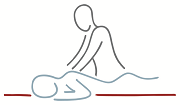The most common footballing injuries, not surprisingly, tend to affect your lower limbs. From hips to feet, injuries from running, twisting, tackling and jumping are affecting athletes week in, week out, across the country.
So how can you avoid the most common injuries and manage to play the whole season? Here are some ideas, if you have any questions please contact me to discuss.
Let’s look at the four most commonly damaged areas:
Ankles:
At grass roots level, many training and playing surfaces are uneven, rutted and slippery. Running in studded boots and changing direction quickly can lead to sprains of the ankle ligaments. To avoid these problems, build strength in your calves and practise balance/ direction change exercises in a controlled environment. This will make sure that your ankles are stronger and well adapted for poor conditions during the season.
Hamstrings:
Your Hamstrings are a group of three large muscles located at the back of the thigh.
These muscles all originate at the Ischial Tuberosity (Sit bone) of the pelvis and wrap around from the back of the knee to attach onto the Tibia and Fibula bones of the lower leg. The Hamstrings are powerful knee flexors and hip extensors. Crossing two joints makes them more prone to strains particularly in sports that involve sudden bursts of speed, like Football.
The main function of the Hamstrings is the push off phase from the back leg in running and walking. They then bend the knee so it can be brought through for the next step. These muscles work alongside the Glutes and can be strengthened using exercises such as deadlifts, hamstring/glute bridges and leg curls. Sprinting drills will also help with specific strengthening. To further reduce the risk of injury, a good warm up before exercise along with stretching, foam rolling and regular massage afterwards will keep the muscles flexible and strong.
Groin:
A strain in the Adductor muscles of the inner thigh is often called a “Groin Strain”. The main symptom of a groin strain is a sudden, sharp pain in the area. Depending on the severity, the player may be unable to continue playing and pain will often be felt when changing direction or pace.
There are five Adductor muscles that attach the lower pelvis to the upper leg bone and pull the leg towards the midline (Adduct). They also stabilize and control the pelvis during walking and running. One side will stabilize while the other moves the leg.
A strain is more likely in muscles that have not been sufficiently warmed up, are weak or tight or have had a previous injury. Therefore, regular stretching and strengthening is vital to avoid this injury. Side lunges are a good exercise to add into your training regime.
Anterior Cruciate Ligament (ACL):
Your A.C.L. is a very important stabilising ligament in your knee and is most commonly injured if your lower leg stays planted while the upper part of your leg twists or moves. It is often damaged during tackles or when studs get stuck in the ground as you change direction. A full tear of this ligament may result in surgery, but a less serious sprain can be managed with manual therapy and re-habilitation exercises.
If you do sustain an injury during your training or match, it’s best to take it easy and allow your body to rest for a few days. Follow the P.OL.I.C.E protocol (Protect, Optimal Loading, Ice, Compression, Elevation) of First Aid and, if your symptoms continue or get worse, consult your doctor and speak to a physiotherapist. They should be able to help by giving advice and showing you some strengthening exercises that will speed up your recovery. To prevent re-occurrence of your injury it is vital that you learn from the experience and adapt your training or playing style accordingly. Your coach and team mates will be able to help you back to full fitness if you incorporate the correct adaptations.
My top tips for avoiding any kind of football related injury are below:
- Strengthen your lower limb muscles.
- Regularly stretch, foam roller and massage your muscles.
- Warm up for EVERY training session and match.
- Work on a strong core for balance.
- Cool down and stretch after EVERY training session and match.
- Wear the correct protective equipment and clothing.
- Eat a healthy diet.
- Get enough rest.

